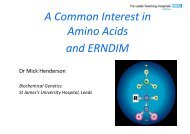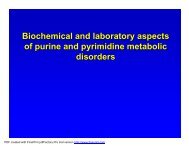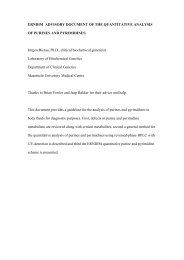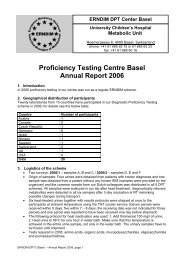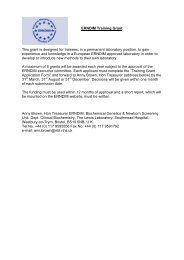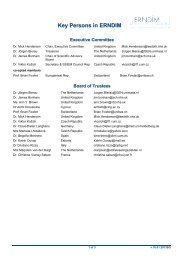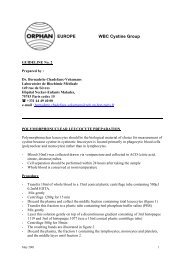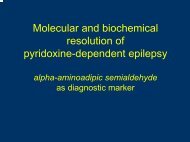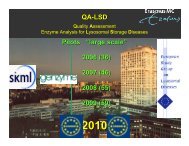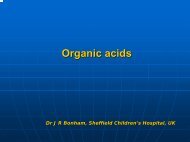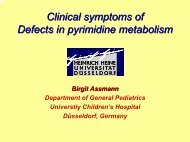Travel Grant Report George van der Watt - ERNDIM
Travel Grant Report George van der Watt - ERNDIM
Travel Grant Report George van der Watt - ERNDIM
You also want an ePaper? Increase the reach of your titles
YUMPU automatically turns print PDFs into web optimized ePapers that Google loves.
August 5, 2009<br />
Professor Brian Fowler and Dr Ann Brown<br />
Chairman and Honorary Treasurer<br />
<strong>ERNDIM</strong><br />
<strong>Report</strong> on <strong>ERNDIM</strong> Training <strong>Grant</strong> awarded to Dr GF <strong>van</strong> <strong>der</strong> <strong>Watt</strong>.<br />
Thank you for your kind contribution<br />
The grant monies awarded by <strong>ERNDIM</strong> were used towards travel and accommodation costs that<br />
enabled me to visit the Sheffield Childrens Hospital Inherited Metabolic Disease Laboratory in the<br />
United Kingdom for a period of 2 weeks in February 2009.<br />
Background:<br />
Over the last 14 months, running the metabolic diagnostic service in Cape Town, South Africa we have<br />
diagnosed 6 new cases of glutaric aciduria type 1 (GA1) (OMIM #231670). In all these cases the<br />
diagnosis was suspected based on clinical findings and organic acid analysis and confirmed locally by<br />
mutational analysis of the glutaryl CoA dehydrogenase (GCD) gene. The recent implementation of a<br />
quality organic acid screening service within our institution has played a significant role in picking up<br />
these patients that may otherwise have gone undiagnosed. The interesting finding in all 6 cases and in<br />
another three known cases has been that all these patients are African children of Southern African<br />
ancestry and all are homozygous for the same A294T substitution, furthermore there is no history of<br />
consanguinity in any of the affected families. We believe that the carrier frequency of this allele may be<br />
high in the local population and have set about investigating this disor<strong>der</strong> in our population.<br />
A third leg in the laboratory diagnosis of GA1 is measurement of GCD activity using radiolabeled<br />
glutaryl-CoA in cultured fibroblasts. This assay plays an essential role in investigating suspected GA1<br />
patients as urine organic screening is not completely sensitive and mutational analysis with complete<br />
gene sequencing is expensive and cannot confirm all cases. Very few laboratories in the world perform<br />
this assay because the labeled reagent is not available commercially. Sheffield Children's Hospital's<br />
Inherited Metabolic Disease Laboratory is one of these.<br />
Drs Jim Bonham, Simon Olpin and Nigel Manning at Sheffield Childrens all kindly agreed to allow me<br />
to visit their laboratory to learn how to synthesize the radiolabeled reagent and run the assay that they<br />
have developed for this disor<strong>der</strong>.<br />
Training Visit:<br />
Division of Chemical Pathology<br />
University of Cape Town and NHLS<br />
ICH Building 1st Floor<br />
Red Cross Childrens Hospital<br />
Rondebosch<br />
Cape Town<br />
7700<br />
Tel 0216585220/4/6<br />
Fax 0216585335<br />
george.<strong>van</strong><strong>der</strong>watt@.uct.ac.za<br />
During the time at Sheffield Childrens after attending a radiation safety course presented by Mrs Tracy<br />
Soames I accompanied Dr Olpin and learnt how to synthesize 1,5 14 C glutaryl-CoA from 1,5 14 C glutaric<br />
acid. The method involves boiling radioactive glutaryl anhydride un<strong>der</strong> reflux – a tricky business and not<br />
for the feint hearted. After synthesizing a batch of the reagent, I then learnt to set up and run the assay<br />
on cultured fibroblasts – this involves trapping released 14 CO2 in fiber-glass filter discs and quantifying<br />
the captured radioactivity by beta emission. After demonstrating expected results in known normal and<br />
abnormal cell lines I then repeated the assay on 3 fibroblast cell lines from our own patients with the<br />
homozygous A294T mutation – all three patients had no detectable GCD enzyme activity.
Page 2 August 5, 2009<br />
In addition to the time spent setting up and running the GCD assay I was also fortunate enough to<br />
review many of the routine diagnostic methods employed within the unit – these included a review of<br />
the following:<br />
• Overview of Software applications to facilitate processing and interpretation of Urine organic<br />
Acid analysis – Dr Nigel manning<br />
• Two dimensional TLC for amino acid screening in body fluids – Dr Camilla Reed<br />
• Fibroblast Immunofluorohistochemical staining for catalase in the screening for peroxisomal<br />
disor<strong>der</strong>s – Dr Camilla Reed<br />
• Fibroblast Fillipin staining for Niemann Pick type C disease – Dr Camilla Reed<br />
• Very Long Chain Fatty Acid analysis by GCMS, methodology and aspects of method<br />
development – Dr Nigel Manning<br />
• Methodologies, data management and structural organization of the dried blood spot NBS<br />
program at Sheffield Children's Hospital – Professor Rodney Pollitt and Dr Melanie Downing<br />
Tutorials on various topics around fatty acid oxidation defects and demonstration of interpretation and<br />
validation of acylcarnitine profiles were also provided throughout the time I spent in the lab by Dr Olpin<br />
and I also attended various patient centred discussions and case presentation<br />
Conclusion:<br />
The visit to Sheffield Children's was a marked success and I would like to take this opportunity to thank<br />
<strong>ERNDIM</strong> and the staff at Sheffield Children's for making the trip possible. I would like to extend special<br />
thanks to Dr Jim Bonham, the laboratory head and joint head of the diagnostic directorate at Sheffield<br />
Children's for supporting and facilitating my visit and a special thanks to Dr's Simon Olpin, Nigel<br />
Manning and Camilla Reed for their friendly help, willingness to share their expertise, patience and<br />
excellent sense of humour.<br />
The knowledge gained and techniques learnt will go a long way to enabling us to improve the<br />
diagnostic service that we provide in South Africa and we hope to set up the GCD assay here in the<br />
near future. It will certainly be put to good use and make a significant contribution towards our<br />
investigation of and research into this disor<strong>der</strong> and it's molecular basis in Southern Africa.<br />
Thank all you once again<br />
Kindest Regards<br />
<strong>George</strong> vd <strong>Watt</strong><br />
<strong>George</strong> F <strong>van</strong> <strong>der</strong> <strong>Watt</strong>, M.B.,Ch.B., D.A.(SA)., F.C.Path.<br />
Chemical Pathologist<br />
Division of Chemical Pathology<br />
Red Cross Children’s Hospital<br />
Rondebosh<br />
Cape Town
Page 3 August 5, 2009<br />
Simon Olpin and <strong>George</strong> vd <strong>Watt</strong> during his visit to Sheffield.



